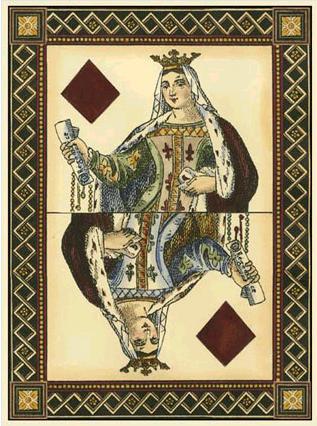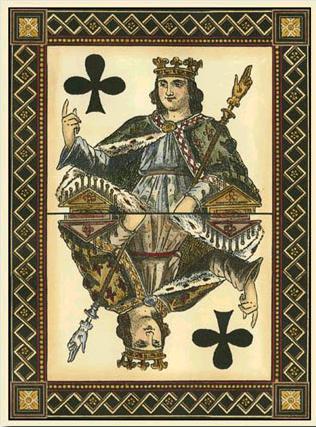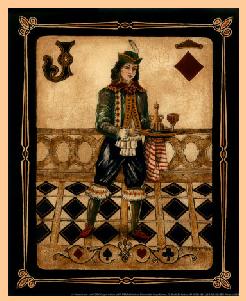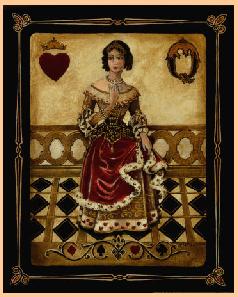
Candida Martinelli's Italophile Site

Main
Page This family-friendly site celebrates Italian culture for the enjoyment of children and
adults. Site-Overview
Trick-Taking Card Games Trick-taking card games are the most
popular card games played around the world.
Each round involves every player adding one card, then one of the
players wins the round and takes the cards, called the trick.
Bridge, or Contract Bridge, devised in 1925, is the
most popular of all. Teaching Children Teaching young children how to play
trick-taking games can be difficult.
The jump from childrenís games like Go Fish to Hearts
or Bridge is often too large for very young children.
But there is a very old trick-taking card game that can bridge the
gap: La Vache or The
Cow Game. The earliest recorded references to a
game like The Cow Game are from the 1300s, but it is likely older
than that. It comes most
probably from the area where Spain meets France, and is still played in
tournaments in some south-western French towns. The Cow Game
is simple because: It ignores card suits
completely, so there is no trump suit. Itís
the highest value card that wins the trick.
The child need concentrate only on the card value Ace-low to
King-high. There is no bidding,
predicting how many tricks a player will take each hand. And it can be played by 2
to 4 players, no need for partners. How to Play The
Cow Game The person to the right of the
dealer plays the first card. The players continue in order, each
playing a card, hoping to win the trick with the highest value card. Ace-low to King-high. The won trick is placed in front of
the trick winner, and that person starts the next trick by playing a
card. Play continues in this way, until all 9 tricks are won. The player who wins the most
tricks, wins the hand. The players can agree ahead of time
on how many hands to play. And
the player who wins the most hands, wins the game. There are only two special rules in
The Cow Game, and they relate to when the high-card values are
tied. When the high-card
values tie, the trick is set aside, and the winner of the next trick
collects both. And when
the last trick of a hand is tied, it goes to the player who won the
first trick of the game. Itís fun to see the children quickly
pick up the strategies that help them win.
They donít need them explained.
They learn them best when left to discover them on their own.
Soon theyíre: drawing out other playerís high
cards, discarding useless low ones when
they can, purposely matching high-cards to
force a tie to hold the trick over for them to win on the next
round, and recalling which cards have
been played--predicting which might still be in play. Partner-Play Have them play with 4 players, and
those seated across from each other trying to win more tricks than the
other team. They very quickly
learn to sacrifice a trick to their partner for the overall win.
And youíll even catch them trying to signal each other!
The original game has many variations, so this is authentic. The Deck of Cards Just one more note.
Iíve described The Cow Game using a standard 52-card deck.
But the traditional game uses a 48-card Spanish deck.
If you wish to be purists but donít have a Spanish deck, just
remove the 10s from a 52-card deck. That
works fine. If you wish to use the Italian deck to help them learn
the Italian cards, it works just as well.
For more trick-taking games, try Wikipediaís
listing. Here are direct links to Amazon.com for
Italian playing cards (there are images at Amazon of all the products)
and two old Italian Tarot card decks, for those
interested in history.
Alida is an
on-line store based in The Republic of San Marino. They ship Italian
playing cards (Tarot, Regional, Historical) all over the world. The
cards are reasonably priced, and shipping is fast (airmail) and very
reasonably priced!
They also sell special historical cards which I think are too beautiful to play
with and should all be framed! I've purchased cards from them
without any problems whatsoever, and an very happy with the GORGEOUS
cards! Visit my Playing
Cards page

The
Cow Game - A Simple Trick-Taking Card Game for Children
![]()

 But
Bridgeís precursors and relations are popular, too.
Solo Whist, for example, a non-partner form of Bridge,
is still played throughout Britain, including at national championships.
And Hearts, a trick-evasion game, is a game commonly played
at family get-togethers. The list is endless, really:
Oh hell, Spades, Pinochle, 500, Euchre, Briscola, SkatÖ
But
Bridgeís precursors and relations are popular, too.
Solo Whist, for example, a non-partner form of Bridge,
is still played throughout Britain, including at national championships.
And Hearts, a trick-evasion game, is a game commonly played
at family get-togethers. The list is endless, really:
Oh hell, Spades, Pinochle, 500, Euchre, Briscola, SkatÖ
 The
first player to deal, shuffles the deck, then deals 9 cards to each
player. The remaining
cards are set aside. The
deal rotates.
The
first player to deal, shuffles the deck, then deals 9 cards to each
player. The remaining
cards are set aside. The
deal rotates.
 The
Cow Game allows them to learn intuitively
the strategies that help them later, when they take up Hearts, Whist,
Bridge, any trick-taking card game.
To move that learning one step further, you can introduce
partner-play to The Cow Game.
The
Cow Game allows them to learn intuitively
the strategies that help them later, when they take up Hearts, Whist,
Bridge, any trick-taking card game.
To move that learning one step further, you can introduce
partner-play to The Cow Game.



